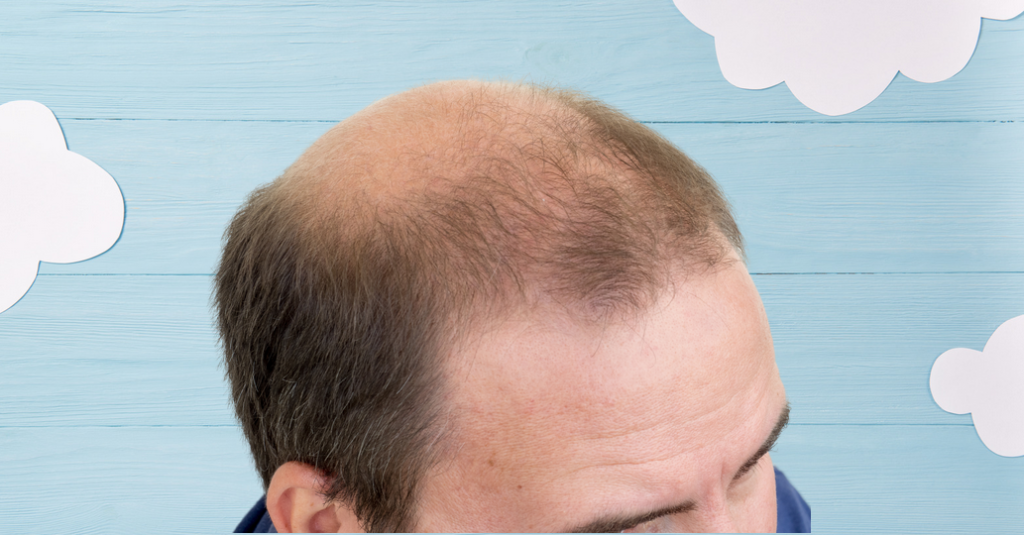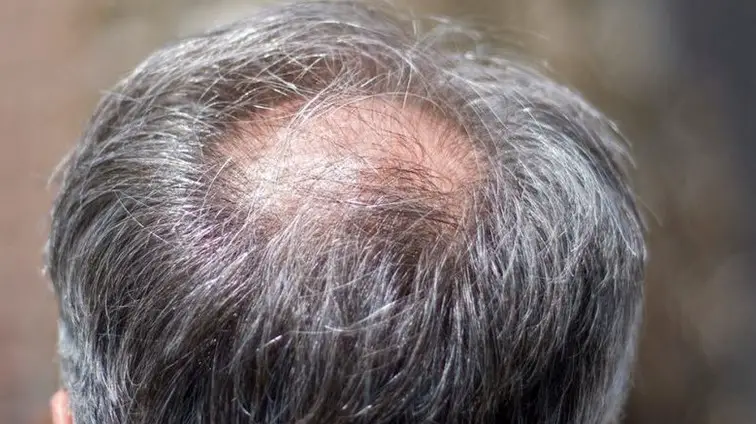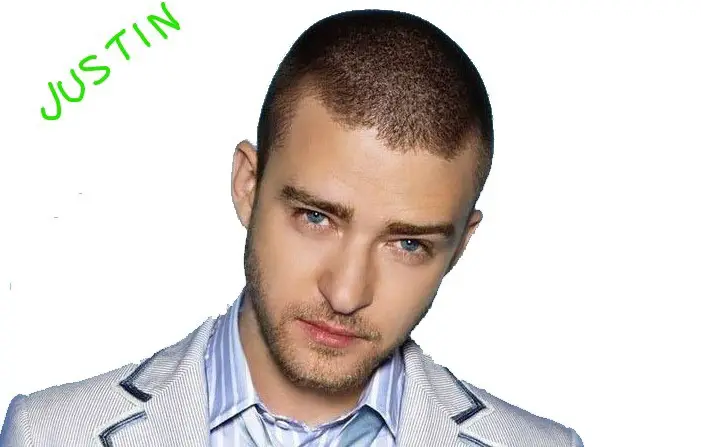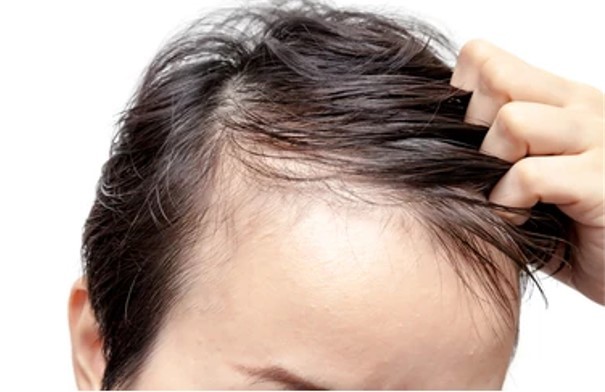Balding at the crown, also known as vertex balding, is a common issue that affects many people, particularly men. It’s a part of life that many of us may have to face, but understanding it can make the process less daunting. In this comprehensive guide, we will delve into the topic of balding at the crown, exploring its causes, signs, and management strategies. We’ll also address some of the most frequently asked questions about this type of hair loss.
Whether you’re just starting to notice a thinning crown or you’ve been dealing with this issue for a while, this article is designed to provide you with valuable insights and practical advice. We’ll cover everything from the science behind why balding starts at the crown to the differences between a normal crown and a balding one.
If you’re interested in learning more about the early stages of balding, you can check out our detailed guide on Early Stages of Balding Crown. This will provide you with a deeper understanding of the progression of hair loss and what to expect.
Remember, knowledge is power. The more you understand about balding at the crown, the better equipped you’ll be to handle it. So, let’s dive in and explore this topic in detail.
Stay tuned, as we’ll also be sharing some effective strategies for managing balding at the crown, including hair care tips and suitable hairstyles. If you’re looking for immediate solutions, our Balding Crown Treatment guide offers a range of options that can help.
Let’s embark on this journey together, understanding and managing balding at the crown one step at a time.
Key Takeaways
Balding at the crown is a common issue that affects many people. However, with the right knowledge and resources, it can be effectively managed. Here are the key takeaways from our comprehensive guide:
- Understanding Balding: Balding at the crown can be caused by various factors, including genetics, hormonal changes, aging, certain health conditions, and lifestyle factors. It’s important to understand these causes to make informed decisions about prevention and treatment strategies.
- Recognizing the Signs: Early signs of balding at the crown include thinning hair and a widening part line. As it progresses, a visible bald spot may appear at the crown. Early detection can make a significant difference in managing hair loss.
- Managing Balding: There are various strategies to manage balding at the crown, from adopting suitable hair care practices to exploring different treatments. For more information, check out our guide on Hair Thinning at Crown Male Treatment.
- Choosing the Right Hairstyle: The right hairstyle can help camouflage thinning hair at the crown. For more tips, explore our guide on Hair Extensions for Balding Crown.
Remember, balding is a natural process, and there’s no need to feel embarrassed or alone. With the right resources and support, you can navigate this journey with confidence. For more insights and practical advice, feel free to explore our other guides on Stages of Balding.
Understanding Balding at the Crown
Balding at the crown is a term that refers to hair loss occurring at the top of the head, also known as the vertex or crown area. This type of hair loss is common, especially among men, and is often a key indicator of male pattern baldness. However, women can also experience crown hair loss, although the pattern and progression may differ.
The process of balding at the crown can be gradual and often starts with the hair beginning to thin out. Over time, the thinning progresses, leading to a visible bald spot. This can be a distressing experience for many, affecting self-esteem and confidence. But understanding why this happens can help in managing the situation better.
The Science Behind Balding at the Crown
Hair loss, including balding at the crown, is often linked to genetics and hormonal changes. The hormone dihydrotestosterone (DHT) plays a significant role. DHT is a byproduct of testosterone, and individuals with a genetic sensitivity to DHT can experience hair follicle shrinkage, leading to hair thinning and eventual loss.
Interestingly, the hair follicles at the crown and the temples are often more sensitive to DHT, which is why balding often starts in these areas. This pattern of hair loss is known as Androgenetic Alopecia or male pattern baldness.
Normal Crown Hair vs Balding Crown
It’s important to distinguish between a normal crown and a balding crown. Everyone has a natural swirl or spiral pattern of hair growth at the crown, often referred to as a “cowlick” or “hair whorl”. This is normal and should not be mistaken for balding.
In contrast, a balding crown starts to show visible thinning and a widening of the part lines. Over time, the hair at the crown becomes increasingly sparse, leading to a circular bald spot. If you’re unsure about the difference, our guide on Normal Crown vs Balding Crown provides a detailed comparison with illustrative images.
Stages of Balding at the Crown
Balding at the crown often follows a predictable pattern, progressing through various stages. The Norwood Scale is commonly used to classify the stages of male pattern baldness, with stages 3 Vertex to 7 indicating significant hair loss at the crown.
Understanding these stages can help you identify where you are in the balding process and guide your decisions about treatment. For a more in-depth look at these crown balding stages, check out our article on the Receding Hairline Stages.
In the next section, we’ll delve into the various causes of balding at the crown. From genetic factors to lifestyle influences, we’ll explore why this type of hair loss occurs and what you can do about it. Stay tuned for more insights and practical advice on managing balding at the crown.
Causes of Balding at the Crown
Balding at the crown is a complex issue with various contributing factors. While it’s often associated with aging, several other factors can influence its onset and progression. Understanding these causes can help you make informed decisions about prevention and treatment strategies.
Genetic Factors
Genetics play a significant role in balding at the crown. If your parents or grandparents experienced hair loss, you’re more likely to experience it too. This genetic predisposition affects how sensitive your hair follicles are to dihydrotestosterone (DHT), a hormone that can cause hair follicles to shrink and eventually stop producing hair.
Hormonal Changes
Hormonal imbalances can also contribute to hair loss. For men, high levels of DHT, a derivative of the male hormone testosterone, can lead to hair loss. Women may experience hair thinning or loss due to changes in estrogen levels, particularly after menopause.
Age
Age is a significant factor in hair loss. As we age, our hair growth cycle slows down, and the hair follicles don’t regenerate as quickly. This can lead to thinning hair and, eventually, balding at the crown.
Health Conditions
Certain health conditions can cause hair loss, including thyroid disorders, anemia, and autoimmune diseases like alopecia areata. Additionally, scalp conditions such as seborrheic dermatitis or psoriasis can lead to temporary hair loss.
Lifestyle Factors
Lifestyle factors such as stress, poor nutrition, smoking, and lack of sleep can also contribute to hair loss. These factors can disrupt the hair growth cycle, leading to shedding and thinning of the hair.
If you’re interested in learning more about the causes of balding, our detailed guide on the Cause of Balding provides a comprehensive overview.
Now that we’ve explored the causes of balding at the crown, it’s crucial to understand the signs to look out for. Early detection can make a significant difference in managing hair loss and exploring treatment options. In the next section, we’ll delve into the signs of balding at the crown, providing you with the knowledge to identify this type of hair loss early on.
Stay tuned as we continue to explore the topic of balding at the crown, providing you with valuable insights and practical advice. Remember, understanding is the first step towards effective management.
Crown of Head Balding
Crown of head balding is a specific type of hair loss that occurs at the top of the head. It’s a common sign of pattern hair loss in both men and women. You might notice a thinning patch of hair or a distinct bald spot developing at the crown of your head. This is different from a cowlick, which is a natural hair growth pattern that can often be mistaken for a bald spot.
A personal anecdote from one of our readers, John, illustrates this difference: “I always had a cowlick at the crown of my head. But as I got older, I noticed the hair in that area was thinning more and more. It wasn’t just the hair standing up in different directions anymore – there was less hair to stand up. That’s when I realized I was dealing with crown of head balding, not just a stubborn cowlick.”
If you’re unsure whether you’re dealing with a cowlick or the early stages of balding, it’s best to consult with a hair loss specialist. They can examine your scalp and hair and provide a proper diagnosis.
Learn more about what is crown of head balding and Signs Of Balding At 20
Signs of Balding at the Crown
Balding at the crown is often a gradual process, and the signs can be subtle at first. Recognizing these early signs can help you take proactive steps towards managing hair loss and exploring treatment options. Here, we’ll explore the key signs of balding at the crown, providing you with the knowledge to identify this type of hair loss early on.
Early Signs to Look For
The first sign of balding at the crown is usually thinning hair. You might notice that your hair doesn’t feel as thick as it used to, or you may see more hair than usual on your brush or in the shower. Another early sign is a widening of the part lines at the crown of your head.
Progression of Balding at the Crown
As balding at the crown progresses, the thinning hair becomes more noticeable. You may start to see a visible bald spot at the crown of your head. This bald spot may gradually increase in size over time.
How to Tell If You’re Balding at the Crown
One way to tell if you’re balding at the crown is to compare current photos of your hair with older ones. Changes in your hair might be subtle and happen over a long period, making them hard to notice day-to-day. Photos can provide a more objective comparison.
Another method is the “pull test”. Gently pull a small bunch of hair (about 60 strands) and see how many come out. If more than six strands come out, it could be a sign of abnormal hair loss.
Differences in Signs Between Males and Females
While both men and women can experience balding at the crown, the pattern of hair loss often differs. Men typically see a receding hairline and thinning at the crown, which can progress into a bald spot. Women, on the other hand, usually experience a general thinning of the hair, with the part line gradually widening.
If you’re unsure about the signs of balding at the crown, our guide on the Early Stages of Balding Crown provides a detailed overview with illustrative images.
Recognizing the signs of balding at the crown is the first step towards managing it. In the next section, we’ll explore various strategies for managing balding at the crown, from hair care tips to suitable hairstyles and treatments. Stay tuned for more insights and practical advice on managing balding at the crown. Remember, early detection and intervention can make a significant difference.
Signs of Balding at the Crown
Balding at the crown is often a gradual process, and the signs can be subtle at first. Recognizing these early signs can help you take proactive steps towards managing hair loss and exploring treatment options. Here, we’ll explore the key signs of balding at the crown, providing you with the knowledge to identify this type of hair loss early on.
Early Signs to Look For
The first sign of balding at the crown is usually thinning hair. You might notice that your hair doesn’t feel as thick as it used to, or you may see more hair than usual on your brush or in the shower. Another early sign is a widening of the part lines at the crown of your head.
Progression of Balding at the Crown
As balding at the crown progresses, the thinning hair becomes more noticeable. You may start to see a visible bald spot at the crown of your head. This bald spot may gradually increase in size over time.
How to Tell If You’re Balding at the Crown
One way to tell if you’re balding at the crown is to compare current photos of your hair with older ones. Changes in your hair might be subtle and happen over a long period, making them hard to notice day-to-day. Photos can provide a more objective comparison.
Another method is the “pull test”. Gently pull a small bunch of hair (about 60 strands) and see how many come out. If more than six strands come out, it could be a sign of abnormal hair loss.
Differences in Signs Between Males and Females
While both men and women can experience balding at the crown, the pattern of hair loss often differs. Men typically see a receding hairline and thinning at the crown, which can progress into a bald spot. Women, on the other hand, usually experience a general thinning of the hair, with the part line gradually widening.
If you’re unsure about the signs of balding at the crown, our guide on the Early Stages of Balding Crown provides a detailed overview with illustrative images.
Recognizing the signs of balding at the crown is the first step towards managing it. In the next section, we’ll explore various strategies for managing balding at the crown, from hair care tips to suitable hairstyles and treatments. Stay tuned for more insights and practical advice on managing balding at the crown. Remember, early detection and intervention can make a significant difference.
Managing Balding at the Crown
While balding at the crown can be a challenging experience, it’s important to remember that there are various strategies available to manage this type of hair loss. From adopting suitable hair care practices to exploring different treatments, you can take proactive steps to manage balding at the crown. Here, we’ll delve into some of these strategies, providing you with practical advice and insights.
Hair Care Tips
Proper hair care can go a long way in managing balding at the crown. Here are some tips:
- Gentle Handling: Be gentle when washing and brushing your hair to avoid unnecessary hair breakage and loss.
- Healthy Diet: A balanced diet rich in vitamins and minerals can support healthy hair growth.
- Avoid Heat and Chemicals: Excessive heat styling and harsh chemical treatments can damage hair and exacerbate hair loss.
Hairstyles for Balding at the Crown
Choosing the right hairstyle can help camouflage thinning hair at the crown. Shorter hairstyles can make your hair look fuller and draw attention away from the balding area. For women, hairstyles with layers can add volume and hide thinning areas.
Treatments Available
There are various treatments available for balding at the crown, ranging from topical treatments to surgical options:
- Topical Treatments: Products like minoxidil can help stimulate hair growth.
- Oral Medications: Drugs like finasteride can help slow hair loss.
- Hair Transplant Surgery: This crown hair transplant is a more permanent solution where hair follicles are transplanted to the balding areas.
- Low-Level Laser Therapy: This treatment uses Red Light Therapy energy to stimulate hair growth.
For a more in-depth look at these treatments, check out our guide on best hair loss products.
When to See a Doctor
If you’re experiencing significant hair loss or if your hair loss is causing you distress, it’s a good idea to see a doctor or a dermatologist. They can help determine the cause of your hair loss and guide you on the best course of treatment.
Remember, balding at the crown is a common issue, and you’re not alone in this journey. With the right knowledge and resources, you can effectively manage this type of hair loss and maintain your confidence. Stay tuned for our next section, where we’ll answer some frequently asked questions about balding at the crown.
Frequently Asked Questions about Balding at the Crown
When it comes to balding at the crown, many questions often arise. Here, we’ll address some of the most frequently asked questions about this type of hair loss, providing you with concise and informative answers.
Does Balding Start at the Crown?
Balding can start at different areas for different people. For some, it may start at the crown, while others may first notice a receding hairline. It’s also possible for balding to occur simultaneously at the crown and the hairline.
How to Stop Balding at the Crown?
While there’s no definitive cure for balding, various treatments can help manage hair loss and promote hair growth. These include topical treatments like minoxidil, oral medications like finasteride, and procedures like hair transplant surgery. Adopting a healthy lifestyle and proper hair care practices can also help. For more information, check out our guide on Balding Crown Treatment.
What Causes Balding at the Crown?
Balding at the crown can be caused by various factors, including genetics, hormonal changes, aging, certain health conditions, and lifestyle factors. For a detailed overview of these causes, refer to our article on the Cause of Balding.
How to Tell If You’re Balding at the Crown?
Signs of balding at the crown include thinning hair, a widening part line, and a visible bald spot at the crown. Comparing current photos of your hair with older ones can also help identify hair loss.
Best Hairstyle for Balding at the Crown?
The best hairstyle for balding at the crown depends on the extent of your hair loss and personal preference. Shorter hairstyles can make hair look fuller and draw attention away from the balding area. For women, layered hairstyles can add volume and hide thinning areas.
Remember, it’s normal to have questions about balding at the crown. The more you know, the better equipped you’ll be to manage it. Stay tuned for our conclusion, where we’ll recap the main points from this comprehensive guide on balding at the crown.
Conclusion
Balding at the crown is a common issue that many people face. While it can be a challenging experience, understanding the causes, signs, and management strategies can help you navigate this journey with confidence.
Remember, balding is a natural process that’s often linked to genetics and hormonal changes. It’s not something to be ashamed of, and there are numerous resources and treatments available to help manage it. From adopting suitable hair care practices to exploring different treatments, you can take proactive steps towards managing hair loss.
In this comprehensive guide, we’ve covered everything from the science behind why balding starts at the crown to the differences between a normal crown and a balding one. We’ve also explored various strategies for managing balding at the crown, from hair care tips to suitable hairstyles and treatments.
If you’re interested in learning more about the early stages of balding, our detailed guide on Early Stages of Balding Crown provides a deeper understanding of the progression of hair loss and what to expect.
Remember, you’re not alone in this journey. With the right knowledge and resources, you can effectively manage balding at the crown and maintain your confidence. We hope this guide has provided you with valuable insights and practical advice on managing balding at the crown.
For more information on related topics, feel free to explore our other guides:
Stay informed, stay confident, and remember, you’re more than your hair.
- AI Powered Bald Filter Online 2024: See Yourself with No Hair! - January 19, 2024
- Harklinikken Bad Reviews 2024: Analyzing Negative Feedbacks - January 18, 2024
- How to Get the Alex Eubank Hair | Step-By-Step Tutorial 2024 - January 18, 2024







